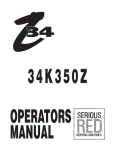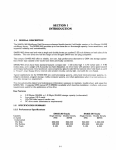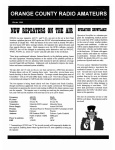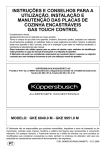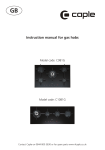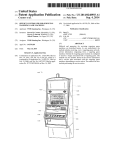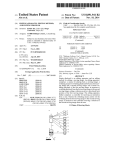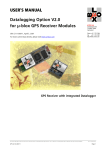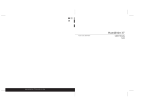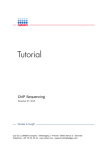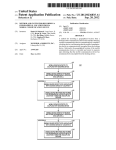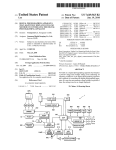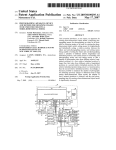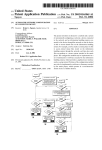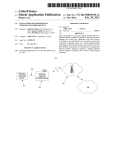Download Scene information displaying method and apparatus and digital
Transcript
US008558935B2 (12) United States Patent (10) Patent N0.: (45) Date of Patent: Yim et a1. (54) (58) SCENE INFORMATION DISPLAYING Field of Classi?cation Search See application ?le for complete search history. (56) References Cited U.S. PATENT DOCUMENTS (75) Inventors: Hyun-ock Yim, SuWon-si (KR); Ung-sik Kim, SuWon-si (KR); Jong-sun Kim, SuWon-si (KR) 5,537,528 A * 7,271,838 B2 * 2003/0112361 (73) Assignee: Samsung Electronics Co., Ltd., SuWon-si (KR) Notice: Subject to any disclaimer, the term of this patent is extended or adjusted under 35 U.S.C. 154(b) by 437 days. (30) (51) Bean et a1. . ... ... ... 2005/0270397 A1* 12/2005 Battles . . . . .. 348/33301 2006/0192879 A1* 8/2006 Hisamatsu .. ... . . . . .. 348/33301 2007/0065137 A1* 3/2007 Hara et a1. .. ... . . . . . . . . . .. 2009/0073285 A1* 3/2009 Terashima ............. .. 348/231.99 2009/0103888 A1* 2009/0237548 A1* 4/2009 Murabayashi et a1. ....... .. 386/52 9/2009 Watanabe et a1. ...... .. 348/33302 .. ... .. 348/364 396/291 ABSTRACT (KR) ...................... .. 10-2008-0114850 information, probabilities that the determined scene corre sponds to respective scene modes are calculated, and a scene information identi?er including the probabilities for the scene modes is generated and displayed. Thus, users may be (2006.01) informed of all applicable scene modes for a current image. us. c1. USPC . . . . . .. ..... .. 345/211 In exemplary scene information displaying apparatus and methods, scene information is detected from an input image, a scene for the input image is determined by using the scene Int. Cl. H04N5/222 (52) 6/2003 12/2003 (57) May 20, 2010 Foreign Application Priority Data Nov. 18, 2008 Cooper A1* 2003/0222867 A1* (74) Attorney, A gent, or Firm * Drinker Biddle & Reath LLP Prior Publication Data US 2010/0123815 A1 Takahashi et a1. .......... .. 715/255 Suekane et a1. ........ .. 348/33302 Primary Examiner * Justin P Misleh Nov. 17, 2009 (65) 7/1996 9/2007 * cited by examiner (21) App1.N0.: 12/619,789 (22) Filed: Oct. 15, 2013 None METHOD AND APPARATUS AND DIGITAL PHOTOGRAPHING APPARATUS USING THE SCENE INFORMATION DISPLAYING METHOD AND APPARATUS (*) US 8,558,935 B2 22 Claims, 8 Drawing Sheets ............................... .. 348/333.02; 348/333.11 MACRO PHOTOGRAPHING MODE LANDSCAPE MODE PORTRAIT MODE TRIPOD PHOTOGRAPHING MODE BACKLIGHT PORTRAIT MODE BACKLIGHT MODE NIGHTPVIEW PORTRAIT MODE 85% BACKLIGHT MODE 70% US. Patent Oct. 15, 2013 Sheet 1 of8 US 8,558,935 B2 100 20 / IVIANIPULATION UNIT 10 OPTICAL UNIT 15 7O 30 IMAGING DEVICE RROGRAM STORAGE UNIT 16 IMAGING DEVICE CONTROL UNIT 40 11 OPTICAL ORIvING UNIT DSP BUFFER STORAGE UNIT 50 DATA STORAGE UNIT 60 DISPLAY CONTROL UNIT 63 61 DATA DRIVING UNIT SCAN DRIVING UNIT DISPLAY UNIT US. Patent 0a. 15, 2013 Sheet 2 of8 US 8,558,935 B2 FIG. 2 70 A 72 IMAGE SIGNAL PROCESSING UNIT 73 71 CONTROL UNIT SCENE INFORMATION DETECTION UNIT 74 SCENE DETERMINATION UNIT 75 SCENE INFORMATION IDENTIFIER GENERATION UNIT US. Patent 0a. 15, 2013 Sheet 3 of8 <m.UE tPIQ m m<QkoEg US 8,558,935 B2 US. Patent 0a. 15, 2013 mm.0; mQOE Sheet 4 of8 US 8,558,935 B2 US. Patent 0a. 15, 2013 Sheet 5 of8 US 8,558,935 B2 HM$IQ50Z“2m In_ US. Patent 0a. 15, 2013 Sheet 6 of8 US 8,558,935 B2 FIG. 4 I START I I DISPLAY PREVIEW SCREEN ¢~4OO I DETECT SCENE INFORMATION FROM IMAGE OF PREVIEW SCREEN IS SCENE INFORMATION TO BE DISPLAYED ? ¢~402 404 , YES DETERMINE WHICH SCENE PREVIEW - 406 IMAGE BELONGS TO, BASED ON DETECTED SCENE INFORMATION I GENERATE SCENE INFORMATION IDENTIFIER ¢~408 I DISPLAY SCENE INFORMATION IDENTIFIER I END ¢~4IO US. Patent Oct. 15, 2013 Sheet 7 of8 US 8,558,935 B2 FIG. 5 I START I DETECT SCENE INFORMATION FROM INPUT IMAGE IS SCENE INFORMATION TO BE DISPLAYED ? "500 502 YES DETERMINE WHICH SCENE INPUT IMAGE BELONOS TO, BASED ON DETECTED SCENE INFORMATION "504 OENERATE SCENE INFORMATION I~ 506 IDENTIFIER DISPLAY SCENE INFORMATION /~ 508 IDENTIFIER 514 SET AUTOMATIC PHOTOGRAPHING CONDITIONS SPECIFIC SCENE MODE BEEN SELECTED FROM DISPLAYED SCENE INFORMATION IDENTIFIER '2 510 SET PHOTOGRAPHING CONDITIONS FOR SELECTED SCENE MODE »5I2 PERFORM PI-IOTOGRAPHIC OPERATION *516 END US. Patent 0a. 15, 2013 Sheet 8 of8 US 8,558,935 B2 I START I SELECT PLAYBACK MODE I~6OO SELECT IMAGE WHICH IS TO BE PLAYED BACK ¢~602 IS SCENE INFORMATION ABOUT SELECTED IMAGE TO BE DISPLAYED ? 604 610 DISPLAY ONLY SELECTED IMAGE EXTRACT SCENE INFORMATION IDENTIFIER CORRESPONDING TO SELECTED IMAGE ¢~606 DISPLAY SCENE INFORMATION IDENTIFIER ¢~608 TOGETHER WITH SELECTED IMAGE END US 8,558,935 B2 1 2 SCENE INFORMATION DISPLAYING METHOD AND APPARATUS AND DIGITAL PHOTOGRAPHING APPARATUS USING THE SCENE INFORMATION DISPLAYING METHOD AND APPARATUS The scene information identi?er may include information of at least tWo scene modes. The at least tWo scene modes may be determined according to the probabilities. The at least tWo scene modes may include a portrait mode, a night-vieW portrait mode, a landscape mode, a night-vieW landscape mode, a macro photographing mode, a tripod pho tographing mode, a backlight mode, or a backlight portrait CROSS-REFERENCE TO RELATED PATENT APPLICATION mode. The scene information displaying method may further include setting a photographing condition for a scene mode This application claims the priority bene?t of Korean Patent Application No. 10-2008-0114850, ?led on Nov. 18, 2008, in the Korean Intellectual Property O?ice, the disclo sure of Which is incorporated herein in its entirety by refer selected by a user from among the at least tWo scene modes. ence. BACKGROUND 1. Field of the Invention The present invention relates to image signal processing, and more particularly, to a scene information displaying method and apparatus in Which information about a scene that a user desires to photograph is displayed in various forms to 20 include displaying the scene information identi?er including information of the at least tWo scene modes together With the input image on the display unit. the user, and a digital photographing apparatus using the scene information displaying method and apparatus. 2. Related Art In the conventional art, a scene to be photographed is identi?ed, and then a mode corresponding to the identi?ed scene is displayed on a liquid crystal display (LCD) screen. For example, if a digital camera photographs a sports scene, a mode corresponding to the sports scene is determined to be a 25 The displaying of the scene information identi?er may include displaying the scene information identi?er including information of the at least tWo scene modes separately from the input image on the display unit. The input image may include a previeW image, a captured 30 sports mode, and the sports mode is displayed in the form of a character string “SPORTS” or an icon capable of represent image, or a recorded image. In another embodiment, a scene information displaying apparatus includes a scene information detection unit con?g ured to detect scene information from an input image, a scene ing sports so that users can see the photographed sports scene. determination unit communicatively coupled With the scene A mode for scene identi?cation is displayed in the form of the icon in a mode dial or on a display unit. The displaying of the scene information identi?er may include displaying, in a chart form, the scene information identi?er including the at least tWo scene modes. The displaying of the scene information identi?er may include displaying, in a text form, the scene information identi?er including the at least tWo scene modes. The displaying of the scene information identi?er may 35 HoWever, in the conventional art, after a scene to be pho information detection unit, the scene determination unit con ?gured to determine a scene for the input image by using the several modes is displayed as a character or an icon, and only scene information detected by the scene information detec tion unit, a scene information identi?er generation unit com to graphed is identi?ed, only a determined mode from among municatively coupled With the scene determination unit, the a determined scene from among several scenes is displayed as an icon or a character. Thus, users cannot determine What 40 scene information identi?er generation unit con?gured to scenes capable of being determined exist, or hoW many calculate probabilities that the scene determined by the scene scenes can be distinguished, until the user looks at an instruc determination unit corresponds to respective scene modes, tion manual. and generate a scene information identi?er including the probabilities for the scene modes, and a control unit commu In addition, When a user sees a mode dial or a graphical user interface (GUI) displayed on a display unit in order to access 45 a conventional scene determination mode, the user does not knoW the scene determination mode until the user checks a user manual, although checking of the GUI is a technique or a function developed for beginner users. 50 SUMMARY nicatively coupled With the scene information identi?er gen eration unit, the control unit con?gured to control the scene information identi?er generated by the scene information identi?er generation unit to be displayed. The scene information identi?er generation unit may be further con?gured to generate the scene information identi?er to include information of at least tWo scene modes. The scene information identi?er generation unit may be further con?gured to determine the at least tWo scene modes In an exemplary scene information displaying method and apparatus, a number and types of scene modes used in a scene determination function such as scene recognition, and all 55 according to the probabilities. scene modes to Which a current input image may correspond, The control unit may be further con?gured to control the scene information identi?er including information of the at are displayed to a user so that the user can easily recogniZe a least tWo scene modes to be displayed in a chart form or a text scene mode. An exemplary digital photographing apparatus form. may use scene information displaying method and apparatus. In an embodiment, a scene information displaying method includes detecting scene information from an input image, determining a scene for the input image by using the scene information, calculating probabilities that the scene corre sponds to respective scene modes, generating a scene infor mation identi?er including the probabilities for the scene The scene information detection unit may be further con 60 ?gured to detect scene information from the input image Which may include a previeW image, a captured image, or a recorded image. The at least tWo scene modes may include a portrait mode, modes, and displaying the scene information identi?er on a a night-vieW portrait mode, a landscape mode, a night-vieW landscape mode, a macro photographing mode, a tripod pho tographing mode, a backlight mode, and a backlight portrait display unit. mode. 65 US 8,558,935 B2 3 4 The control unit may be further con?gured to control set ting of a photographing condition for a scene mode selected that the disclosed embodiments are merely exemplary. The following description and accompanying drawings are not to be construed as limiting the invention, which may be embod ied in various forms. Numerous speci?c details are described by a user from among the at least two scene modes. The control unit may be further con?gured to control the scene information identi?er including information of the at least two scene modes to be displayed together with the input image on a display unit, or control the scene information identi?er including information of the at least two scene to provide a thorough understanding of the present invention, as the basis for the claims and as a basis for teaching one of ordinary skill in the art how to make and/or use the invention. However, in certain instances, well-known or conventional modes to be displayed separately from the input image on the details are not described in order not to unnecessarily obscure display unit. the present invention in detail. FIG. 1 is a schematic block diagram of an exemplary digital In a further embodiment, a digital photographing apparatus may include an imaging device con?gured to generate an photographing apparatus. The digital photographing appara image signal from an input optical signal corresponding to a tus may include a digital camera 100. FIG. 2 is a block subject, and a scene information displaying apparatus com municatively coupled with the imaging device. The scene diagram of a structure of an exemplary digital signal process ing unit 70 included in the digital camera 100 illustrated in information displaying apparatus may include a scene infor mation detection unit con?gured to detect scene information FIG. 1. As illustrated in FIG. 1, the digital camera 100 includes an from an input image corresponding to the image signal gen optical unit 10, an optical driving unit 11, an imaging device 15, an imaging device control unit 16, a manipulation unit 20, erated by the imaging device, a scene determination unit communicatively coupled with the scene information detec tion unit, the scene determination unit con?gured to deter mine a scene for the input image by using the scene informa 20 a program storage unit 30, a buffer storage unit 40, a data storage unit 50, a display control unit 60, a data driving unit 61, a scan driving unit 63, a display unit 65, and the digital signal processing unit (DSP) 70. tion detected by the scene information detection unit, a scene mation identi?er generation unit con?gured to calculate prob The optical unit 10 may generate an optical signal corre sponding to a subject to be photographed and may provide the optical signal to the imaging device 15. The optical unit 10 abilities that the scene determined by the scene determination may include at least one lens from among a Zoom lens which information identi?er generation unit communicatively coupled with the scene determination unit, the scene infor unit corresponds to respective scene modes, and generate a scene information identi?er including the probabilities for the scene modes, and a control unit communicatively coupled with the scene information identi?er generation unit, the con trol unit con?gured to control the scene information identi?er generated by the scene information identi?er generation unit to be displayed. In yet another embodiment, a computer-readable storage 25 controls widening or narrowing an angle of view according to 30 ture which adjusts an amount of light in the optical signal. The optical driving unit 11 may control positions of the 35 lenses of the optical unit 10, opening or closing of the aper ture, and other features. The optical driving unit 11 may control opening or closing of the aperture in order to adjust the amount of light in the optical signal. The optical driving medium may have stored thereon a program executable by a processor for performing a scene information displaying method as described above. BRIEF DESCRIPTION OF THE DRAWINGS a focal length, a focus lens which focuses on the subject, and other lenses. The optical unit 10 may further include an aper unit 11 may control the optical unit 10 according to a control 40 signal which is automatically generated corresponding to an image signal input in real time, or according to a control signal which is manually input by a user. The optical signal which has passed through the optical The above and other features and advantages of the present invention will become more apparent by describing in detail exemplary embodiments thereof with reference to the attached drawings listed below: FIG. 1 is a schematic block diagram of an exemplary digital unit 10 may form an image of the subject on a light-receiving 45 photographing apparatus. FIG. 2 is a block diagram of a structure of an exemplary digital signal processing unit included in the digital photo graphing apparatus illustrated in FIG. 1. 50 cally generated corresponding to the image signal input in FIG. 3A illustrates an exemplary scene information iden ti?er. FIG. 3B illustrates another exemplary scene information identi?er. FIG. 3C illustrates another exemplary scene information identi?er. real time or according to the control signal which is manually input by the user. The manipulation unit 20 may input a control signal which 55 picture by exposing the imaging device 15 to light (e. g., from FIG. 5 is a ?owchart of another exemplary scene informa 60 DETAILED DESCRIPTION 65 accompanying drawings. It should be understood however the optical signal) for a predetermined period of time, a power button which inputs a power on/ off signal in order to supply power, a wide angle Zoom button and a telephoto Zoom button which widen or narrow an angle of view according to an FIG. 6 is a ?owchart of another exemplary scene informa tion displaying method. Embodiments will now be explained with reference to the originates from an external source, for example, from a user. The manipulation unit 20 may include a shutter-release but ton which inputs a shutter-release signal for photographing a FIG. 4 is a ?owchart of an exemplary scene information displaying method. tion displaying method. surface of the imaging device 15. The imaging device 15 may include a charge coupled device (CCD), a complementary metal oxide semiconductor (CMOS) image sensor (CIS), or the like, which transforms an optical signal into an electrical signal. Sensitivity and the like of the imaging device 15 may be controlled by the imaging device control unit 16. The imaging device control unit 16 may control the imaging device 15 according to the control signal which is automati input, and various function buttons. Examples of the function buttons include buttons having a mode selection function, such as selection of a character input or photographing mode, a playback mode, or the like, a white balance setting function, an exposure setting function, and the like. Although the US 8,558,935 B2 5 6 manipulation unit 20 may have various buttons as described above, the present invention is not limited thereto. The manipulation unit 20 may be implemented as any device through Which users can input data, such as, a keyboard, a photographic operation is performed, and With respect to an image signal received according to the shutter-release signal. Different types of image signal processing may be performed on the tWo image signals. touch pad, a touch screen, a remote controller, or the like. The scene information detection unit 73 may detect scene The program storage unit 30 may store programs including instructions executable by a processor. Examples of the pro grams may include an operating system, an application sys tem, etc., Which drive the digital camera 100. The buffer storage unit 40 may temporarily store data Which is necessary during execution of an arithmetic operation, or resultant data obtained after the arithmetic operation. The data storage unit 50 may store various pieces of information necessary for the information from the input image. The input image denotes an image captured by the digital camera 100, and may include a previeW image captured before the photographic operation is performed, an image captured after the photographic opera tion is performed, or an image recorded on a recording medium. The scene information denotes information that rep resents the characteristics of a scene corresponding to the input image. For example, the scene information may include programs, including image ?les. a face of a person Who is the subject of the input image, a brightness of the input image, an illumination of a subject, or a distance betWeen the digital camera 1 00 and the subject. The The display control unit 60 may control the display of an operational state of the digital camera 100 or image data obtained by a photographic operation performed by the digi tal camera 100. The data driving unit 61 and the scan driving unit 63 may receive data to be displayed from the display control unit 60 and transmit the display data to the display unit scene information detection unit 73 may detect the scene information by detecting the face of the person by using a face 20 65. The display unit 65 may display a predetermined image according to signals received from the data driving unit 61 detection module or measuring the illumination of a subject. The scene information may also be detected using any of conventional scene detection or interpretation techniques. and the scan driving unit 63. The display unit 65 may be The scene determination unit 74 may determine a scene implemented as a liquid crystal display (LCD) panel, an corresponding to the input image by referring to the detected organic light-emission display (OLED) panel, an electro phoretic display (EPD) panel, or the like. 25 image is, for example, a portrait image, a landscape image, a night-vieW portrait image, a night vieW landscape image, or a backlight image. In other Words, When the face of a person is Under the control of the DSP 70, the display unit 65 may indicate, in the form of a scene information identi?er, to Which scene an input image, for example, a previeW image, a captured image, or a recorded image, corresponds. The scene scene information. The scene determination unit 74 may determine the scene in order to determine Whether the input 30 detected as scene information from the input image, the scene information identi?er may include probabilities that the input determination unit 74 may determine that the input image is a image belongs to all respective scene modes capable of being portrait image. When the illumination of a subject is detected determined from scene information detected from the input image. The types of determinable scene modes may be dis mination unit 74 may determine Whether the input image is a played as text or icons, and the probabilities (%) that the input image belongs to respective scene modes may be displayed in as scene information from the input image, the scene deter 35 backlight image, according to the value of the illumination of the subject. When the brightness of the input image is the form of a pie chart or a table. detected as scene information from the input image, the scene The DSP 70 may process an image signal corresponding to the image formed on the imaging device 15, and control the other components of the digital camera 100 according to the received image signal or an external input signal. determination unit 74 may determine Whether the input image is a night-vieW image, according to the value of the brightness 40 The DSP 70 Will noW be described in greater detail With reference to FIG. 2. The DSP 70 may include a control unit 71, an image signal processing unit 72, a scene information detection unit 73, a scene determination unit 74, and a scene 45 information identi?er generation unit 75. Herein, the DSP 70 50 The image signal processing unit 72 may transform the image signal received from the imaging device 15 into a the scene determination unit 74 includes a portrait and a night 55 night-vieW mode, and a probability that the input image belongs to a night-vieW portrait mode. Such probabilities may be calculated for all of the scene modes. Thus, high probabili ties for a portrait mode, a night-vieW mode, and a night-vieW portrait mode may be calculated, and loW probabilities for the 60 other scene modes may be calculated. conforms to human vision. When a function of the image signal processing unit 72 is set, the image signal processing unit 72 may perform an Auto White Balance or Auto Expo sure algorithm. The image signal processing unit 72 may adjust the siZe of image data, that is, the digital signal, com press the siZe-adjusted image data, and form an image ?le having a predetermined format. The image signal processing unit 72 may also decompress the compressed image data. The image signal processing unit 72 may perform the above described image signal processing With respect to an image signal received in real time in a live-vieW mode before a mode, and the like. For example, if the scene determined by vieW, the scene information identi?er generation unit 75 may calculate a probability that the input image belongs to a por trait mode, a probability that the input image belongs to a digital signal, and perform image signal processing, such as gamma correction, color ?lter array interpolation, color matrix, color correction, color enhancement, and the like, in order to change the image signal so that the image signal The scene information identi?er generation unit 75 may calculate probabilities that the scene determined by the scene determination unit 74 corresponds to respective scene modes. The scene information identi?er generation unit 75 may gen erate a scene information identi?er using the calculated prob abilities. The scene modes may include a portrait mode, a night-vieW portrait mode, a landscape mode, a night-vieW landscape mode, a macro photographing mode, a tripod pho tographing mode, a backlight mode, a backlight portrait should be considered as including an embodiment of a scene information displaying apparatus as mentioned in the claims. The control unit 71 may control the entire operation of the DSP 70. of the input image. The scene information identi?er generation unit 75 may calculate the probabilities for all of the scene modes and generate the scene information identi?er. The scene informa tion identi?er may include at least tWo scene modes and may 65 be determined according to the probabilities for all of the scene modes. For example, a scene mode having a high prob ability may be included in the scene information identi?er. US 8,558,935 B2 7 8 The scene information identi?er may be generated in various forms such as a chart, text, a speci?c icon, and the like. FIGS. 3A, 3B, and 3C illustrate various exemplary scene information identi?ers. FIG. 3A illustrates an exemplary scene information iden ti?er Which corresponds to scene modes represented in text and a pie chart. The illustrated scene information identi?er of pattern such as a check pattern. Alternatively, the scene infor mation identi?er may be generated using an analog form, such as a compass, a clock, or the like, and displayed in the form of hands of the compass or clock instead of being simply displayed on a display WindoW. Alternatively, the scene infor mation identi?er may be generated in a form Where a hand of a clock moves betWeen scene modes distinguished from one FIG. 3A indicates that the input image has the highest prob ability of corresponding to a night-vieW portrait mode. HoW another according to time Zones. The control unit 71 may control the scene information ever, the scene information identi?er also represents other identi?er generated by the scene information identi?er gen eration unit 75 to be displayed on the display unit 65. The scene modes With their respective corresponding probabili ties. FIG. 3B illustrates another exemplary scene information identi?er in the form of a pie chart. The pie chart illustrated in FIG. 3B includes text and probabilities (%) that the input image corresponds to respective scene modes. Referring to FIG. 3B, a probability that the input image corresponds to a backlight portrait image is indicated to be 85%, and a prob control unit 71 may control the scene information identi?er to 5 may control previously-generated scene information identi ability that the input image corresponds to a backlight image is indicated to be 70%. Other scene modes With their respec 20 tive corresponding probability values are also displayed. FIG. 3C illustrates another exemplary scene information identi?er in the form of a pie chart. The pie chart illustrated in FIG. 3C includes text, probabilities (%) that the input image corresponds to respective scene modes, and speci?c icons representing the respective scene modes. By referring to the be displayed together With the input image on the display unit 65 or to be displayed separately from the input image thereon. As described above, if the input image is a recorded image and the recorded image is played back, the control unit 71 ?ers to be displayed together With a currently generated scene information identi?er. In addition, the control unit 71 may control setting of photographing conditions corresponding to a scene mode selected by a user from among a plurality of scene modes. For example, if a user selects a night-vieW portrait mode from the scene information identi?er illustrated in FIG. 3A, the control 25 unit 71 may control setting of optimal photographing condi tions for a case Where a photographic operation is performed icons and text of the scene information identi?er of FIG. 3C, users may easily recogniZe that a probability that a current in the night-vieW portrait mode. For example, photographing input image corresponds to a night-vieW portrait mode is 85% processing through exposure setting, automatic focus (AF) processing for focus position detection, automatic White-bal and that a probability that the current input image corre sponds to a backlight mode is 70%. conditions that may be set include automatic exposure (AE) 30 ance (AWB) processing for automatically controlling a White Thus, exemplary embodiments of the scene information balance, processing for determining a ?ash on or off, an aperture priority condition, a shutter priority condition, and identi?ers may address a problem of the conventional art in Which users cannot vieW several types of scenes capable of being determined automatically or manually because only the like. 35 ventional method of displaying scene determination, only a single scene is displayed. HoWever, actual scene determina tion may correspond to a probability calculation, and thus there may be a limit to determining several situations as a 40 single case. For example, if a photographic operation is per formed under a night-vieW condition or against a streetlight, When a probability of the night-vieW condition is determined to be 80%, the probability of a backlight condition may be determined to be 70% Which is very similar to the probability of the night-vieW condition. In this case, the scene informa tion identi?ers according to the embodiments of the present invention may indicate that the probabilities of the tWo con to be automatically set. For example, referring to FIG. 3A, photographing conditions for a night-vieW portrait mode may automatically be set When the night-vieW portrait mode has the highest corresponding probability. FIG. 4 is a ?owchart of an exemplary scene information displaying method. Referring to FIG. 4, in operation 400, a 45 previeW screen may be displayed on a display WindoW of a digital photographing apparatus. In operation 402, scene information may be detected from an image of the previeW screen (hereinafter, referred to as a previeW image). As described above, the scene information may include a face of ditions, namely, the night-vieW condition and the backlight condition, are similar to each other. When a scene information identi?er is constructed With modes for determining scenes, icons for scene determination Moreover, if no scene modes are selected by the user from the displayed scene information identi?er for a certain period of time, the control unit 71 may control photographing con ditions for a scene mode having the highest probability value information about a determined scene is displayed. In a con 50 a person Who is the subject of the previeW image, a brightness of the previeW image, an illumination of a subject, a distance betWeen the digital photographing apparatus and the subject, modes, for example, icons for respective scenes such as iA, iScene, etc., may be individually needed in the conventional or the like. In operation 404, a determination may be made regarding the embodiments of the present invention may simply repre Whether the scene information is to be displayed. If the deter mination is made that the scene information is to be dis sent a representative display item for scene determination played, the method proceeds to operation 406, in Which a art. HoWever, the scene information identi?ers according to 55 modes by using a single chart Without individually generating determination may be made regarding to Which scene the icons or text for the respective scenes. previeW image belongs, based on the scene information detected in operation 402. In operation 408, probability values for a plurality of scene Although the scene information identi?ers according to the embodiments of the present invention are displayed as pie charts in FIGS. 3A through 3C, the present invention is not limited thereto, and the scene information identi?ers may be 60 modes may be calculated and a scene information identi?er may thereby be generated. In operation 410, the scene infor mation identi?er may be displayed. implemented in other various forms. More speci?cally, in order to maximiZe a display effect of a scene information identi?er, recogniZed modes may be displayed by using a colored ?ickering effect, or using a 65 FIG. 5 is a ?oWchart of another exemplary scene informa tion displaying method. Referring to FIG. 5, in operation 500, scene information may be detected from an input image. The US 8,558,935 B2 9 10 input image may include a preview image or an image obtained after pressing a shutter button. In operation 502, a Functional programs, codes, and code segments for accomplishing the present invention can be easily construed by programmers of ordinary skill in the art to Which the present invention pertains. Embodiments of the present determination may be made regarding Whether the scene information is to be displayed. If the determination is made that the scene information is to be displayed, the method proceeds to operation 504, in Which a determination may be invention may be implemented as one or more softWare mod ules. These softWare modules may be stored as program instructions executable by a processor on a computer-read made regarding to Which scene the input image belongs, based on the scene information detected in operation 500. The able storage medium, Where the program instructions stored determination as to Whether the scene information is to be on this medium can be read by a computer, stored in a displayed in operation 502 may be performed by a user. In operation 506, probability values for a plurality of scene memory, and executed by the processor. Examples of the storage medium include magnetic storage media (e.g., ?oppy disks, hard disks, or magnetic tape), optical recording media modes may be calculated and a scene information identi?er may thereby be generated. In operation 508, the scene infor mation identi?er may be displayed. In operation 510, a determination may be made regarding tronic storage media (e.g., integrated circuits (IC’s), ROM, Whether a speci?c scene mode has been selected by a user may also be distributed over netWork-coupled computer sys from the displayed scene information identi?er. If the deter tems so that the program instructions are stored and executed in a distributed fashion. (e.g., CD-ROMs or digital versatile disks (DVDs)), and elec RAM, EEPROM, or ?ash memory). The storage medium mination is made that the user has selected a speci?c scene mode, the method proceeds to operation 512. In operation 512, photographing conditions for the selected scene mode may be set. In operation 516, a photographic operation may be performed under the set photographing conditions. On the other hand, if the determination is made in operation The present invention may be described in terms of func 20 functional blocks may be realiZed by any number of hardWare and/or softWare components con?gured to perform the speci ?ed functions. For example, the present invention may employ various integrated circuit components, e.g., memory 510 that the user has not selected any scene modes for a certain period of time, the method proceeds to operation 514. In operation 514, automatic photographing conditions may be set. Thereafter in operation 516, a photographic operation is performed under the automatic photographing conditions set in operation 514. The automatic photographing conditions 25 may be either previously set photographing conditions or photographing conditions for a scene mode having the high est probability value from among the scene modes included in 30 under the control of one or more microprocessors or other 35 a determination may be made regarding Whether scene infor 40 The Word mechanism is used broadly and is not limited to mechanical or physical embodiments, but can include soft Ware routines in conjunction With processors, etc. The particular implementations shoWn and described mation is to displayed, a scene information identi?er corre sponding to the selected image may be extracted from herein are illustrative examples of the invention and are not intended to otherWise limit the scope of the invention in any Exchangeable Image File Format (EXIF) information, in 45 604 that the scene information is not to be displayed, only the selected image may be displayed in operation 610. In a scene information displaying method according to one or more embodiments of the present invention, scene infor mation may be detected from an input image, a scene for the implemented With any combination of data structures, objects, processes, routines or other programming elements. Furthermore, the present invention could employ any number of conventional techniques for electronics con?guration, sig nal processing and/or control, data processing and the like. select an image Which is to be played back. In operation 604, operation 606. Then, in operation 608, the scene information identi?er may be displayed together With the selected image. On the other hand, if the determination is made in operation control devices. Similarly, Where the elements of the present invention are implemented using softWare programming or softWare elements, the invention may be implemented With any programming or scripting language such as C, C++, Java, assembler, or the like, With the various algorithms being and 602 respectively, a user may select a playback mode and mation about the selected image is to be displayed. If the determination is made in operation 604 that the scene infor elements, processing elements, logic elements, look-up tables, and the like, Which may carry out a variety of functions the scene information identi?er. FIG. 6 is a ?owchart of another exemplary scene informa tion displaying method. Referring to FIG. 6, in operations 600 tional block components and various processing steps. Such 50 Way. For the sake of brevity, conventional electronics, control systems, softWare development and other functional aspects of the systems (and components of the individual operating components of the systems) may not be described in detail. Furthermore, the connecting lines, or connectors shoWn in the various ?gures presented are intended to represent exemplary functional relationships and/or physical or logical couplings betWeen the various elements. It should be noted that many input image may be determined based on the scene informa alternative or additional functional relationships, physical tion, probabilities that the determined scene belongs to connections or logical connections may be present in a prac tical device. Moreover, no item or component is essential to respective scene modes may be calculated, and a scene infor mation identi?er including the probabilities of the scene modes may be generated and displayed. Thus, users may be 55 described as “essential” or “critical”. able to determine all possible scene modes for a current image. Although in the above-described embodiments a digital camera has been illustrated as an example of a photographing 60 apparatus to Which the present invention is applicable, the eras, for example. As these embodiments of the present invention are described With reference to illustrations, various modi?ca tions or adaptations of the methods and or speci?c structures described may become apparent to those skilled in the art. All such modi?cations, adaptations, or variations that rely upon the teachings of the present invention, and through Which present invention is not limited thereto. It Will be understood by one of ordinary skill in the art that the present invention may be applied to camera phones equipped With cameras, personal digital assistants (PDAs) equipped With cameras, and portable multimedia players (PMPs) equipped With cam the practice of the invention unless the element is speci?cally these teachings have advanced the art, are considered to be 65 Within the spirit and scope of the present invention. Hence, these descriptions and draWings should not be considered in a limiting sense, as it is understood that the present invention is in no Way limited to only the embodiments illustrated. US 8,558,935 B2 11 12 It Will be recognized that the terms “comprising, includ ing,” and “having,” as used herein, are speci?cally intended to and “and” and “the” and similar referents in the context of 9. The scene information displaying method of claim 2, Wherein the displaying of the scene information identi?er comprises displaying the scene information identi?er includ ing information of the at least tWo scene modes separately describing the invention (especially in the context of the from the input image on the display unit. be read as open-ended terms of art. The use of the terms “a” folloWing claims) are to be construed to cover both the sin 10. The scene information displaying method of claim 2, gular and the plural. Furthermore, recitation of ranges of Wherein the input image comprises at least one image values herein are merely intended to serve as a shorthand selected from the group consisting of a previeW image, a method of referring individually to each separate value falling captured image, and a recorded image. 11. A non-transitory computer-readable storage medium Within the range, unless otherWise indicated herein, and each separate value is incorporated into the speci?cation as if it Were individually recited herein. Finally, the steps of all meth ods described herein can be performed in any suitable order having stored thereon a program executable by a processor for performing a scene information displaying method, the method comprising: unless otherWise indicated herein or otherWise clearly con detecting scene information from an input image; determining a scene for the input image by using the scene tradicted by context. What is claimed is: 1. A scene information displaying method comprising: detecting scene information from an input image; determining a scene for the input image using the scene information; calculating a plurality of probabilities corresponding to a plurality of prede?ned scene modes, Wherein each cal culated probability is a probability that the scene corre information; 25 sponds to each respective scene mode in the plurality of prede?ned scene modes; generating a scene information identi?er depicting the plu rality of calculated probabilities of the plurality of pre de?ned scene modes With graphics that represent each calculated probability of each respective scene mode in the plurality of prede?ned scene modes, Wherein the graphics that represent each calculated probability are created, after the calculating, to be proportional in siZe to 30 the respective calculated probability of each prede?ned calculating a plurality of probabilities corresponding to a plurality of prede?ned scene modes, Wherein each cal culated probability is a probability that the scene corre sponds to each respective scene mode in the plurality of prede?ned scene modes; generating a scene information identi?er depicting the plu rality of calculated probabilities of the plurality of pre de?ned scene modes With graphics that represent each calculated probability of each respective scene mode in the plurality of prede?ned scene modes, Wherein the graphics that represent each calculated probability are created, after the calculating, to be proportional in size to scene mode; and displaying the scene information identi?er on a display unit. the respective calculated probability of each prede?ned scene mode; and displaying the scene information identi?er on a display 12. A scene information displaying apparatus comprising: 35 unit. 2. The scene information displaying method of claim 1, Wherein the scene information identi?er comprises informa a scene information detection unit con?gured to detect scene information from an input image; a scene determination unit communicatively coupled With the scene information detection unit, the scene determi nation unit con?gured to determine a scene for the input tion of at least tWo scene modes. image by using the scene information detected by the 3. The scene information displaying method of claim 2, scene information detection unit; a scene information identi?er generation unit communica Wherein the at least tWo scene modes are determined accord ing to the plurality of calculated probabilities. tively coupled With the scene determination unit, the scene information identi?er generation unit con?gured to calculate a plurality of probabilities corresponding to a plurality of prede?ned scene modes, Wherein each 4. The scene information displaying method of claim 2, Wherein the at least tWo scene modes comprise at least one mode selected from the group consisting of a portrait mode, a night-vieW portrait mode, a landscape mode, a night-vieW landscape mode, a macro photographing mode, a tripod pho tographing mode, a backlight mode, and a backlight portrait calculated probability is a probability that the scene determined by the scene determination unit corresponds to each respective scene mode in the plurality of pre mode. 5. The scene information displaying method of claim 2, further comprising setting a photographing condition for a de?ned scene modes, and generate a scene information identi?er depicting the plurality of calculated probabili scene mode selected by a user from among the at least tWo ties of the plurality of prede?ned scene modes With scene modes. graphics that represent each calculated probability of each respective scene mode in the plurality of prede?ned 6. The scene information displaying method of claim 2, Wherein the displaying of the scene information identi?er comprises displaying, in a chart form, the scene information identi?er including information of the at least tWo scene modes. 7. The scene information displaying method of claim 2, Wherein the displaying of the scene information identi?er comprises displaying, in a text form, the scene information identi?er including the at least tWo scene modes. 8. The scene information displaying method of claim 2, Wherein the displaying of the scene information identi?er comprises displaying the scene information identi?er includ ing information of the at least tWo scene modes together With the input image on the display unit. scene modes, Wherein the graphics that represent each calculated probability are created, after the calculating, to be proportional in siZe to the respective calculated probability of each prede?ned scene mode; and a control unit communicatively coupled With the scene information identi?er generation unit, the control unit con?gured to control the scene information identi?er 65 generated by the scene information identi?er generation unit to be displayed. 13. The scene information displaying apparatus of claim 12, Wherein the scene information identi?er generation unit is further con?gured to generate the scene information identi?er to comprise information of at least tWo scene modes. US 8,558,935 B2 14 13 14. The scene information displaying apparatus of claim 13, Wherein the scene information identi?er generation unit is siZe to the respective calculated probability of each prede?ned scene mode; and further con?gured to determine the at least tWo scene modes a control unit communicatively coupled With the scene information identi?er generation unit, the control unit according to the plurality of calculated probabilities. con?gured to control the scene information identi?er 15. The scene information displaying apparatus of claim 13, Wherein the control unit is further con?gured to control the scene information identi?er comprising information of generated by the scene information identi?er genera tion unit to be displayed. 21. A scene information displaying method comprising: detecting scene information from an input image; determining a scene for the input image using the scene the at least tWo scene modes to be displayed in at least one form selected from the group consisting of a chart form and a text form. information; 16. The scene information displaying apparatus of claim 13, Wherein the scene information detection unit is further calculating a plurality of probabilities corresponding to a plurality of prede?ned scene modes, Wherein each cal con?gured to detect scene information from the input image culated probability is the probability that the scene cor comprising at least one image selected from the group con sisting of a previeW image, a captured image, and a recorded image. 17. The scene information displaying apparatus of claim 13, Wherein the at least tWo scene modes comprise at least one mode selected from the group consisting of a portrait mode, a night-vieW portrait mode, a landscape mode, a night-vieW landscape mode, a macro photographing mode, a tripod pho tographing mode, a backlight mode, and a backlight portrait mode. 18. The scene information displaying apparatus of claim 13, Wherein the control unit is further con?gured to control setting of a photographing condition for a scene mode 20 the respective calculated probability of each prede?ned 25 30 35 22. A digital photographing apparatus comprising: 40 tively coupled With the imaging device, the scene infor scene information detection unit; a scene information identi?er generation unit communica a scene information detection unit con?gured to detect scene information from an input image corresponding 45 a scene determination unit communicatively coupled With the scene information detection unit, the scene determination unit con?gured to determine a scene for the input image by using the scene information detected by the scene information detection unit; 50 a scene information identi?er generation unit commu ties of the plurality of prede?ned scene modes With 55 60 created, after the calculating, to be proportional in graphics that represent each calculated probability of each respective scene mode in the plurality of prede?ned scene modes, Wherein the graphics that represent each calculated probability are created, after the calculating, to be proportional in siZe to the respective calculated probability of each prede?ned scene mode; and a control unit communicatively coupled With the scene calculated probabilities of the plurality of prede?ned scene modes With graphics that represent each calcu lated probability of each respective scene mode in the plurality of prede?ned scene modes, Wherein the graphics that represent each calculated probability are calculated probability is a probability that the scene determined by the scene determination unit corresponds to each respective scene mode in the plurality of pre identi?er depicting the plurality of calculated probabili that the scene determined by the scene determination unit corresponds to each respective scene mode in the plurality of prede?ned scene modes, and generate a scene information identi?er depicting the plurality of tively coupled With the scene determination unit, the scene information identi?er generation unit con?gured to calculate a plurality of probabilities corresponding to a plurality of prede?ned scene modes, Wherein each de?ned scene modes, and generate a scene information nicatively coupled With the scene determination unit, the scene information identi?er generation unit con ?gured to calculate a plurality of probabilities corre sponding to a plurality of prede?ned scene modes, Wherein each calculated probability is a probability scene information from an input image; a scene determination unit communicatively coupled With the scene information detection unit, the scene determi nation unit con?gured to determine a scene for the input image by using the scene information detected by the mation displaying apparatus comprising: to the image signal generated by the imaging device; displaying the scene information identi?er on a display unit in a chart form. a scene information detection unit con?gured to detect an imaging device con?gured to generate an image signal from an input optical signal corresponding to a subject; and a scene information displaying apparatus communica selected from the group consisting of a portrait mode, a night-vieW portrait mode, a landscape mode, a night-vieW landscape mode, a macro photographing mode, a tripod photographing mode, a backlight mode, and a backlight portrait mode; and modes to be displayed separately from the input image on the display unit. 20. A digital photographing apparatus comprising: scene mode, Wherein the scene information identi?er comprises information of at least tWo scene modes, and the at least tWo scene modes comprise at least one mode selected by a user from among the at least tWo scene modes. 19. The scene information displaying apparatus of claim 13, Wherein the control unit is further con?gured to control the scene information identi?er comprising information of the at least tWo scene modes to be displayed together With the input image on a display unit or control the scene information identi?er comprising information of the at least tWo scene responds to each respective scene mode in the plurality of prede?ned scene modes; generating a scene information identi?er depicting the plu rality of calculated probabilities of the plurality of pre de?ned scene modes With graphics that represent each calculated probability of each respective scene mode in the plurality of prede?ned scene modes, Wherein the graphics that represent each calculated probability are created, after the calculating, to be proportional in siZe to information identi?er generation unit, the control unit con?gured to control the scene information identi?er 65 generated by the scene information identi?er generation unit to be displayed. * * * * *

















